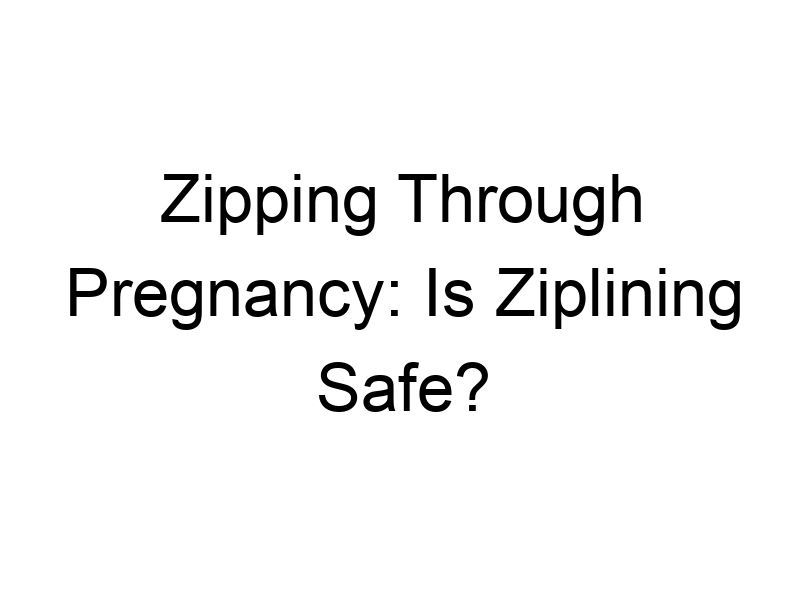Thinking about taking on a zipline while expecting? It’s a question many adventurous moms-to-be ponder. While ziplining is a thrilling outdoor activity, pregnancy often brings a mix of excitement and caution. The big question is: can you zipline while pregnant? Let’s break down the key takeaways to help you make an informed decision.
Key Takeaways
- Ziplining during pregnancy is generally not recommended due to safety concerns.
- The physical demands and potential risks to the baby are key considerations.
- Consulting with a healthcare provider is crucial before deciding to zipline.
- Many zipline companies have policies against pregnant participants.
- There are safer alternative activities for expecting mothers to enjoy.
Understanding the Risks of Ziplining While Pregnant
Potential Physical Strain on the Body
Ziplining is a thrilling activity, but it demands physical strength and endurance, which might not be ideal during pregnancy. The act of holding onto the harness, bracing during takeoff, and the sudden stops can put unexpected strain on your body. Pregnancy already places significant demands on your body, and adding the physical exertion of ziplining might be more than your body can comfortably handle.
Impact on the Developing Baby
The safety of your baby is, of course, the top priority. The jarring movements and rapid changes in direction associated with ziplining could potentially affect the baby. While there’s no direct evidence linking ziplining to pregnancy complications, the lack of data doesn’t guarantee safety. It’s better to err on the side of caution when it comes to activities that involve dynamic movements and potential impacts.
Safety Concerns with Equipment
Equipment safety is another critical consideration. A zipline harness, for instance, is designed for secure fits and might not accommodate a growing belly comfortably or safely. There’s a risk that the harness could be too tight or not secure enough, posing a safety risk. Additionally, the equipment must be in excellent condition to ensure safety, and any failure could lead to accidents.
It’s essential to weigh the thrill of the experience against the potential risks involved, especially when pregnant. Prioritizing safety and comfort can help ensure a healthy pregnancy.
Medical Advice on Ziplining During Pregnancy
Consulting Your Healthcare Provider
Before embarking on any adventure, especially one as thrilling as ziplining, it’s crucial to talk to your healthcare provider. Your doctor knows your medical history best and can offer personalized advice. They might consider factors like your pregnancy stage, any complications you might have, and your overall health. This consultation can help you weigh the risks and benefits, ensuring that you make a decision that’s right for you and your baby.
Common Medical Recommendations
Doctors often advise against ziplining during pregnancy. The reasons include the physical demands of the activity, the potential for falls or collisions, and the stress it could place on your body. Here’s a quick rundown of typical recommendations:
- Avoid activities that involve high speeds or sudden stops.
- Be cautious with activities that could lead to abdominal trauma.
- Consider the potential for nausea or dizziness, which can be exacerbated by ziplining.
Listening to Your Body’s Signals
Pregnancy is a time when your body goes through significant changes, and it’s essential to pay attention to what it’s telling you. If you’re feeling fatigued, experiencing discomfort, or just not up for a thrill, it’s okay to sit this one out. Trusting your instincts is key during this time. After all, your comfort and safety, along with your baby’s, are the top priorities.
Pregnancy is a journey filled with its own set of adventures. While ziplining might be off the table, there are countless other ways to enjoy this special time.
The First Trimester: To Zipline or Not?
Physical Changes in Early Pregnancy
In the first trimester, your body is already starting to change, even if you can’t see it. Hormones are kicking in, and you might feel more tired or nauseous than usual. These changes can make physical activities like ziplining more tiring. Your body is working hard to support a new life, and that can mean less energy for adventure.
Potential Discomforts and Risks
Ziplining might sound fun, but there are a few things to think about. The harness can be uncomfortable, especially if you’re dealing with tender breasts or a sensitive bladder. Plus, nausea could make the ride less enjoyable. Some women breeze through the first trimester with no issues, but for others, these discomforts are real.
- Increased fatigue
- Frequent bathroom breaks
- Possible nausea
Personal Experiences and Stories
Some women have shared their experiences of ziplining during the first trimester. While some had no problems, others found it challenging. The key is to listen to your body and decide what’s best for you.
“I thought ziplining would be a breeze, but the harness was just too tight, and I felt queasy the whole time.”
Remember, every pregnancy is different. It’s important to weigh the potential risks and discomforts before deciding to go ziplining. If you’re unsure, talking to your healthcare provider can help guide your decision. And if ziplining doesn’t feel right, there are always other eco-adventures to explore.
Navigating the Second Trimester: Is Ziplining Safe?
Increased Physical Demands
During the second trimester, many pregnant women notice a surge in energy, but this doesn’t mean it’s time to throw caution to the wind. Ziplining can be physically demanding, requiring strength and endurance that might be challenging during pregnancy. The added weight and changes in your body can make activities that were once easy feel a bit more taxing.
Changes in Balance and Coordination
Pregnancy brings about changes in your balance and coordination, thanks to your growing belly and shifting center of gravity. This can make activities like ziplining more risky, as maintaining stability on platforms and during take-off and landing becomes harder. A slight misstep could lead to a fall, which is why it’s crucial to consider these shifts before deciding to zipline.
Expert Opinions and Guidelines
Most experts suggest avoiding high-risk activities during pregnancy, and ziplining often falls into this category. While some may feel confident in their ability to zipline safely, it’s essential to weigh the potential risks. Consulting with your healthcare provider is always a good step before engaging in such activities. They can provide personalized advice based on your health and pregnancy progress.
“Pregnancy is a time to embrace change and listen to your body. Every decision should prioritize the safety of both you and your developing baby.”
In summary, while the second trimester might seem like a good time to try ziplining due to increased energy, the risks associated with balance, physical demands, and expert advice suggest it might be best to explore other exciting yet safer activities.
Third Trimester Considerations for Ziplining
Significant Physical Changes
By the third trimester, your body has undergone a lot of changes. The size of your belly can make it difficult to fit comfortably in a zipline harness. You might also experience back pain and shortness of breath. These physical changes can make the idea of ziplining daunting. Plus, the risk of Braxton Hicks contractions increases, which can be unsettling when you’re high up in the air.
Increased Risk Factors
As your due date approaches, the risk factors associated with ziplining become more pronounced. The physical strain of the activity can exacerbate existing pregnancy-related discomforts. There’s also the potential risk of falling or being jolted suddenly, which could be harmful to both you and your baby. It’s crucial to weigh these risks carefully before deciding to zipline.
Alternative Activities to Consider
If ziplining seems too risky, there are plenty of other ways to enjoy the outdoors. Consider more gentle activities like hiking or nature walks. You could also enjoy a scenic boat tour or be a supportive spectator for friends who are ziplining. These activities allow you to enjoy nature without the added risks.
Pregnancy is a unique time, and while it may mean skipping certain activities, it also opens the door to new, safer experiences. Remember, it’s just a temporary pause, and the adventures will still be there after your little one arrives.
For those looking for a relaxing getaway, check out the top babymoon destinations in the USA for a peaceful retreat during your pregnancy.
Safety Measures for Pregnant Women Considering Ziplining
Choosing the Right Zipline Course
When it comes to ziplining during pregnancy, picking the right course is key. Look for courses that are known for their safety records and have experienced guides. Avoid courses that are overly strenuous or have a reputation for being particularly challenging. It’s also wise to inquire about the course’s policies regarding pregnant participants. Some places might have specific restrictions or recommendations.
Understanding Safety Protocols
Before you strap in, make sure you understand all the safety protocols. This includes knowing how the harness works and what to do in case of an emergency. Guides will usually provide a safety briefing before the activity begins, so pay close attention. If you’re unsure about anything, don’t hesitate to ask questions. The more informed you are, the safer you’ll be.
Importance of Proper Equipment
Proper equipment is crucial for a safe ziplining experience, especially when you’re pregnant. The harness should fit comfortably without putting unnecessary pressure on your abdomen. You might want to try on different sizes to find the best fit. Remember, harness discomfort is a common concern for pregnant individuals, so don’t ignore any unease you might feel.
Always remember, your safety and your baby’s well-being should be your top priority. Ziplining might be an exciting adventure, but it’s not worth risking your health. Consider all factors and listen to your body before deciding to go ziplining.
Alternatives to Ziplining for Expecting Mothers

Pregnancy doesn’t mean you have to miss out on outdoor adventures. While ziplining might not be the best choice right now, there are plenty of other activities to enjoy. Exploring nature safely is still totally possible!
Gentle Outdoor Activities
- Hiking: A great way to stay active and soak in the beauty of nature. Choose trails that are less strenuous and have plenty of shade.
- Nature Walks: Perfect for those who want a more relaxed pace. It’s a wonderful opportunity to connect with the environment and enjoy some fresh air.
- Scenic Boat Tours: Experience the tranquility of being on the water without the physical demands of more intense activities.
Enjoying Nature Safely
- Hot Air Balloon Rides: For those seeking a bit of thrill without the physical exertion, a hot air balloon ride offers stunning views and a unique experience.
- Picnics in the Park: Enjoy a leisurely day outdoors with family or friends, surrounded by nature’s beauty.
- Bird Watching: A calming activity that allows you to engage with nature at your own pace.
Participating as a Spectator
- Cheer on Friends: If your friends or family are ziplining, you can still be part of the fun by cheering them on from the sidelines.
- Photography: Capture the moments and scenery while others take on the adventure.
- Planning Future Adventures: Use this time to plan for future escapades, like exploring ideal babymoon destinations once the baby arrives.
Pregnancy is a special time to cherish. While some activities might be on hold, there’s still a world of adventure waiting for you. Embrace this unique period and look forward to the many exciting moments to come.
Personal Stories: Ziplining Experiences During Pregnancy

Positive Experiences and Outcomes
Some pregnant women have shared positive experiences ziplining, especially during the early stages of pregnancy. For some, the thrill of ziplining provided a sense of normalcy and adventure amidst the many changes happening in their bodies. Despite some concerns, many reported feeling safe and exhilarated. They chose zipline courses with gentle slopes and ensured all safety measures were in place.
Challenges Faced by Pregnant Women
Of course, not all experiences were smooth sailing. Some women encountered challenges such as harness discomfort and heightened fatigue. The physical demands of ziplining can amplify common pregnancy symptoms like nausea or dizziness. It’s also worth noting that some zipline companies have strict policies regarding pregnant participants, similar to cruise lines that often restrict travel during certain pregnancy stages.
Lessons Learned from Others
Hearing from those who have been there can be invaluable. Many women emphasize the importance of listening to one’s body and consulting healthcare providers before engaging in such activities. They advise considering the type of zipline course and the stage of pregnancy. Ultimately, it’s about balancing the desire for adventure with the need for safety.
Pregnancy is a unique journey, and while adventure calls, it’s crucial to weigh the risks and benefits carefully. Many find joy in alternative activities, knowing that ziplining and other thrills will still be there post-pregnancy.
Making an Informed Decision About Ziplining While Pregnant

Weighing the Pros and Cons
When you’re pregnant, every choice feels like it carries extra weight, and deciding whether to zipline is no different. Ziplining offers an exhilarating experience, but it’s crucial to weigh the thrill against potential risks. On the plus side, it’s an opportunity to enjoy the great outdoors and feel a rush of adrenaline. However, the cons might include the physical strain on your body and the risk of accidents, which could have serious implications during pregnancy.
Considering Personal Health and Fitness
Your personal health and fitness level play a big role in this decision. If you’ve been active and have a strong fitness routine, you might feel more confident about handling the physical demands of ziplining. But if your pregnancy comes with complications or if you’re not feeling your best, it might be wise to reconsider. Listening to your body is key—if something feels off, it probably is.
Planning for a Safe Adventure
If you decide to go ahead with ziplining, planning is essential. Choose a reputable company with a strong safety record and ensure they have experience accommodating pregnant participants. Before you go, check their safety protocols and discuss any concerns with the guides. Consider these steps:
- Talk to your healthcare provider about your plans.
- Ensure the zipline course is not too physically demanding.
- Double-check that the harness fits comfortably and securely.
Pregnancy is a time of joy and anticipation, but also caution. While adventures like ziplining may be tempting, always prioritize your safety and that of your baby. Remember, there will be plenty of time for thrill-seeking once your little one arrives.
The Role of Zipline Companies in Ensuring Safety
Company Policies on Pregnant Participants
Zipline companies take safety seriously, especially when it comes to pregnant participants. Most companies have strict policies prohibiting pregnant women from ziplining due to the potential risks involved. This is not just about liability but also about ensuring the well-being of both the mother and the unborn child. These policies are often outlined clearly in the waiver forms or during the booking process. For instance, ziplining tours often have rules against smoking, drugs, and alcohol, and explicitly state that pregnant women are not permitted to participate.
Training and Expertise of Guides
The guides at zipline courses are trained to handle a variety of situations, ensuring that every participant can enjoy the experience safely. Guides undergo rigorous training to understand how to operate the equipment, manage groups, and respond to emergencies. They are knowledgeable about the course and can provide valuable insights and instructions to participants. Their expertise helps in maintaining a safe environment, minimizing risks, and ensuring that all safety protocols are followed.
Ensuring Equipment Safety
Equipment safety is a top priority for zipline companies. Regular inspections and maintenance of harnesses, cables, and other gear are conducted to ensure everything is in perfect working condition. Companies invest in high-quality equipment that meets or exceeds industry standards. This meticulous attention to detail helps prevent accidents and ensures that participants can focus on enjoying the thrill of the ride without worrying about equipment failure.
Safety isn’t just a policy—it’s a commitment that zipline companies make to every participant. By maintaining high standards and continuously improving their safety measures, they aim to provide a thrilling yet secure adventure for everyone.
Understanding the Thrill and Risks of Ziplining

The Adrenaline Rush Explained
Ziplining is one of those activities that gets your heart racing and puts a grin on your face. Imagine soaring through the air, the wind rushing past you, and the world unfolding below—it’s a mix of excitement and freedom that feels almost magical. This adrenaline rush comes from the speed and height, which can make your body feel alive and buzzing with energy. But it’s not just about the thrill; it’s also about the beauty of nature. As you glide through the trees, you get a unique view of the landscape, making ziplining an unforgettable experience.
Balancing Thrill with Safety
While the thrill is undeniable, it’s crucial to think about safety. Ziplining companies usually have strict protocols to keep everyone safe. Here’s what they often focus on:
- Equipment Checks: Regular inspections of harnesses, cables, and pulleys to ensure everything is in tip-top shape.
- Guide Training: Skilled guides are trained to handle any situation, making sure your ride is as safe as it is fun.
- Participant Guidelines: Clear instructions on what to do and what not to do, keeping everyone on the same page.
For pregnant women, it’s essential to consider how these factors play into their unique situation. The activity can be a bit too intense, so weighing the excitement against potential risks is important.
Why Some Choose to Wait
Despite the allure of ziplining, some folks decide it’s best to hold off, especially if they’re expecting. The zero tolerance policy for drugs and alcohol is a testament to how seriously safety is taken, but pregnancy adds another layer of complexity. With the body’s changes and the possibility of unexpected movements, some prefer to wait until after the baby arrives to indulge in such adventures. They might opt for gentler activities that still offer a taste of the outdoors without the same level of risk. After all, there’s plenty of time for ziplining once the baby is safely in their arms.
Pregnancy is a time to cherish and protect, and while the thrill of ziplining is tempting, waiting can be a wise choice. The adventures will still be there when you’re ready.
The Psychological Impact of Adventure Activities During Pregnancy
Managing Anxiety and Stress
Pregnancy can be a rollercoaster of emotions, and managing anxiety and stress is crucial for both mother and baby. Adventure activities, like ziplining, might seem like a fun way to blow off steam, but they can also introduce new stressors. The fear of potential harm, coupled with the physical demands, might outweigh the thrill. It’s important to weigh the excitement against the potential for increased anxiety. Some women find that gentler activities, such as hiking or nature walks, provide a better balance of adventure and relaxation.
The Joy of Outdoor Adventures
For many expecting mothers, the thrill of outdoor adventures is a unique way to connect with nature. Being outdoors, surrounded by the beauty of the natural world, can be incredibly uplifting. Engaging in activities like skiing during pregnancy can offer a sense of freedom and joy, helping to enhance mood and reduce stress. The key is to choose activities that are safe and comfortable, allowing you to enjoy the great outdoors without worry.
Balancing Excitement with Caution
While the idea of ziplining might be exhilarating, it’s essential to balance that excitement with caution. Pregnancy is a time to be mindful of your body’s signals and limitations. Consider alternative activities that offer a similar thrill without the risks. Listening to your body and consulting with your healthcare provider can help you make informed decisions. Remember, there’s plenty of time for high-adrenaline adventures after the baby arrives.
Pregnancy is a transformative journey, filled with both challenges and joys. Embracing safe, enjoyable activities can enrich this experience, providing moments of happiness and connection with nature.
Conclusion
So, is ziplining a good idea when you’re pregnant? Well, it’s a bit of a mixed bag. On one hand, some folks say it’s no big deal, especially in the early stages. But on the other hand, there are plenty of reasons to be cautious. The harness might not fit right, the physical demands could be too much, and let’s not forget about the risk of a sudden jolt or fall. Plus, your body is already going through a lot, so why add more stress? At the end of the day, it’s all about what feels right for you. Talk to your doctor, weigh the pros and cons, and make the choice that’s best for you and your little one. Remember, there are plenty of other ways to get your adventure fix without taking unnecessary risks. Enjoy this special time and look forward to all the fun you can have once the baby arrives!
Frequently Asked Questions
Can I go ziplining while pregnant?
It’s generally not advised to go ziplining while pregnant due to potential risks such as falls, high speeds, and sudden stops that could harm you or your baby.
Why do some zipline companies restrict pregnant women?
Many zipline companies restrict pregnant women to ensure safety, as the harnesses may not fit properly and the activity can be physically demanding.
What are the risks of ziplining during pregnancy?
Risks include falling, pressure from the harness on the belly, and the jarring motion of ziplining, which can all pose dangers to a developing baby.
Is it safe to zipline in the first trimester?
Even in the first trimester, ziplining can be risky due to potential falls and the physical demands of the activity, so it’s best to consult your doctor.
Are there safer alternatives to ziplining for pregnant women?
Yes, pregnant women can enjoy safer activities like nature walks, gentle hiking, or simply watching others zipline from a safe distance.
How do physical changes during pregnancy affect ziplining?
Pregnancy brings changes like weight gain and balance issues, making it harder to safely participate in activities like ziplining.
Should I consult my doctor before ziplining while pregnant?
Absolutely, always talk to your healthcare provider before engaging in any adventure activities during pregnancy to ensure your safety and your baby’s.
Can I zipline if I don’t have a visible baby bump yet?
Even if your bump isn’t showing, the risks remain due to the nature of ziplining, so it’s important to prioritize safety over thrill.



